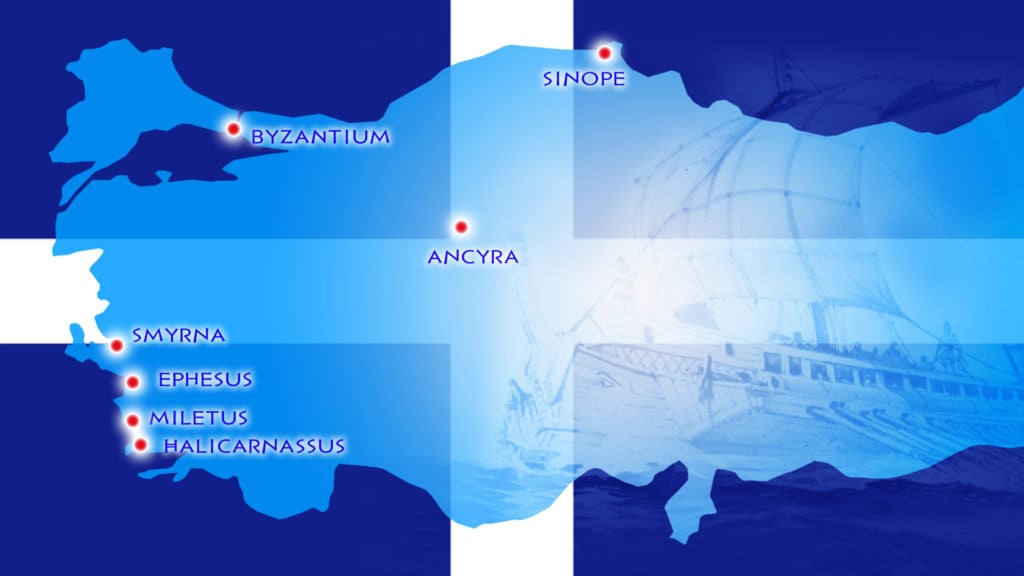
Turkey was once full of Greek cities which were the cradle of ancient Greek scientific and philosophical thought. Visitors can still find the remnants of a glorious past.
Byzantium/Constantinople
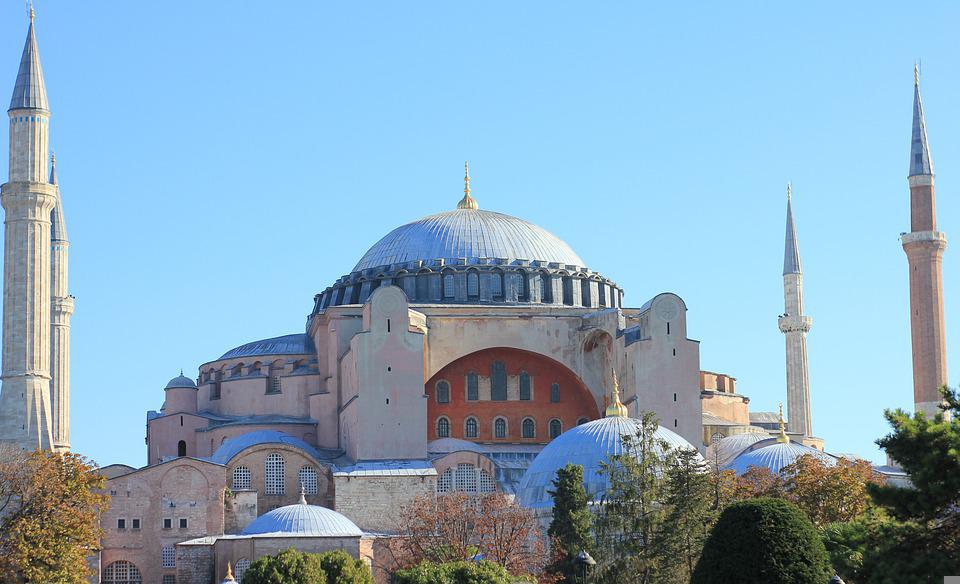
The city of Istanbul in Turkey, known in the past as Constantinople, has a rich history and has seen the rise and the fall of the world’s most famous empire.
The “City” (Polis/Πολις), as Constantinople used to be called, has a special place in the hearts of Greeks, as it was the seat of the most long-lived empire in the world, the Roman. More specifically, Constantinople served as the capital of the Greek speaking Orthodox Christian Eastern Roman Empire (Byzantine) and thus of the Ecumenical Patriarchate, which is still thriving today.
The lingua franca of the Eastern Roman Empire was Greek while the western part of the empire used Latin.
Although it is believed that ‘Constantinople’ may have been inhabited as early as 3,000 BC, it was not a city until Greek settlers arrived in the area in the 7th century BC. Led by King Byzas, the leader of the Megarian colonists, settlers from mainland Greece founded the city. In fact, Byzantium, as Constantinople was initially called, derived its name from King Byzas.
Τhe area was chosen because of its strategic location along the Bosporus Straits. Byzantium was mainly a trading post due to its location at the Black Sea’s only entrance.
Crescent Moon and Star an Ancient Greek Symbol
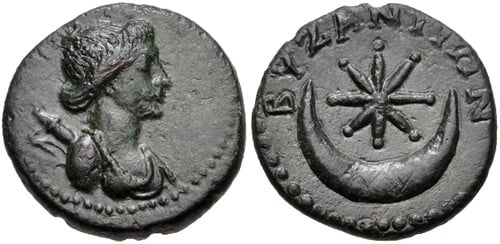
Τhe star and crescent motif was, to some degree, emblematic of the ancient city until the late Hellenistic or early Roman period.
Certain Byzantine coins of the 1st century BC and later depict the head of the goddess Artemis with bow and quiver and feature a crescent with what appears to be an eight-rayed star on the reverse.
The Byzantines especially favored goddess Hecate for her protection from the incursions of the fellow Greek king, Philip of Macedon. Her symbols were the crescent and star, and the walls of her city were her provenance.
Ancyra/Ankara
During the Hellenistic period, the city was known as Ancyra (perhaps from the Greek Ἄγκυρα, meaning anchor) from which the slightly modified version of the name, Ankara, used in Turkey today, derives.
The city was conquered by Alexander the Great, who came from Gordion to Ankara and resided in the city for a short period in 333 BC.
After his death at Babylon in 323 BC and the subsequent division of his empire amongst his generals, Ankara and its environs passed into the hands of Antigonus. Apart from the Phrygian period in which the city experienced its largest expansion in ancient times, another vital expansion took place under the Greeks of Pontus.
Pontic Greeks developed the city into a trading center for the commerce of goods between the Black Sea ports and Crimea to the north.
According to legend, the city was built by King Midas where an anchor was found; the anchor symbol also appears on ancient coins. This legend is likely due to the confusion between the Greek word which designates an anchor and the ancient root of the toponym.
Ankara was once populated by the Hittites and later the Greeks, but today the city is the capital of Turkey.
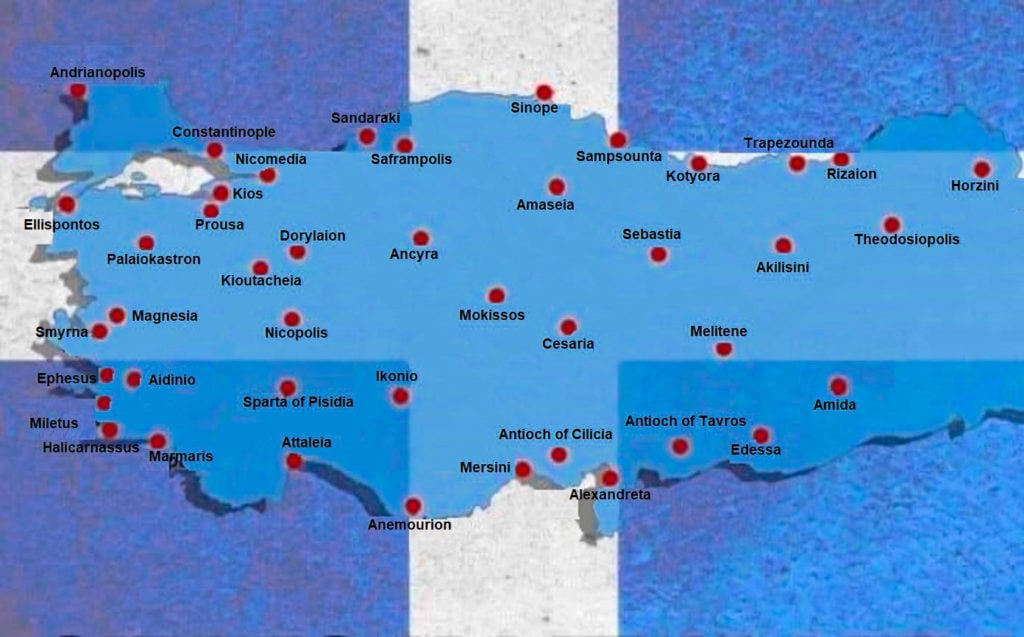
Smyrna/Izmir
The Greek settlement of Old Smyrna is known for its ancient pottery dating from about 1,000 BC onwards.
According to Herodotus, the city was founded by Aeolian Greeks and later seized by Ionian Greeks.
The city’s actual location has changed twice throughout its long history. Its prehistoric location is mentioned by Strabo and referred to as “Old Smyrna” while the second city was built by Alexander the Great and his descendants during the Hellenistic period.
The slopes of Mount Pagus (Kadifekale) were selected as the location of the new city for
which Alexander is credited. This laid the ground for a resurgence in the city’s population.
The most ancient ruins that have been preserved to this day date back to 725 to700 BC. Homer, referred to as Melesigenes, meaning “Child of the Meles Brook,” is said to have been born in Smyrna in the 7th or 8th century BC.
From the 7th century onwards, Smyrna was known as a city-state.
Old Smyrna’s most significant sanctuary was the Temple of Athena, which dates back to 640 to 580 BC and is partially restored today.
The reconstruction of the history and topography of Hellenistic and Roman Smyrna has become more accessible as a result of ancient sources, while excavations have played less of a role.
The only excavations that took place in the 1930s south of Mount Pagus also revealed the public market and the altar of Zeus.
Halicarnassus/Halikarnas
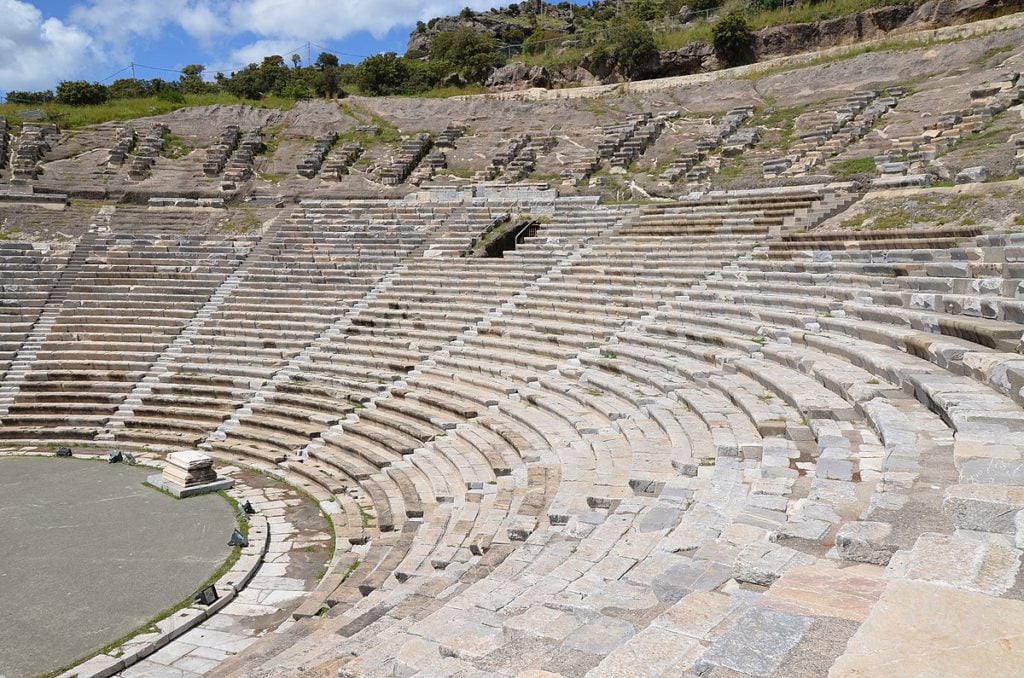
The oldest evidence of Greek presence in Turkey is associated with the more than forty Mycenaean-type burial places in Muskebi near Halicarnassus. These are believed to be from around the end of the 15th century BC to approximately the 12th century BC. Halicarnassus was located in southwest Caria, on an advantageous site on the Gulf of Gökova, which is now in Bodrum, Turkey.
There are many legends about the founding of Halicarnassus in circulation, but all these legends attest to the fact that it was indeed a Dorian colony.
The inhabitants appear to have accepted Anthes, a son of Poseidon, as their legendary founder, as mentioned by Strabo, and were proud of the title of Antheadae. This statement, as well as the hypothesis that Troezen and Argos were the mother cities of the new colony, is supported by the figures on the city’s coins. Figures found on coins include the head of Medusa, Athena or Poseidon, or the symbol of the trident.
Halicarnassus was initially a member of the Doric Hexapolis, which was later expelled from the league.
Amongst the most notable figures of Halicarnassus are the historian Herodotus and Dionysius, the poet Pigres, and the rhetorician Aelius Dionysius. Others include the elegiac poet Heraclitus and Artemisia I.
Today’s ancient ruins of the city include part of the ancient walls around modern Bodrum, the remains of several temples, the big theatre of the city, and ruins of one of the seven wonders of the ancient world.
Furthermore, the famous monumental mausoleum and a tomb that was built for Mausolus, a native Carian satrap of the 4th century BC are also noteworthy sites. These were recovered by the 1857 excavations of Charles Newton.
Ephesus/Efes
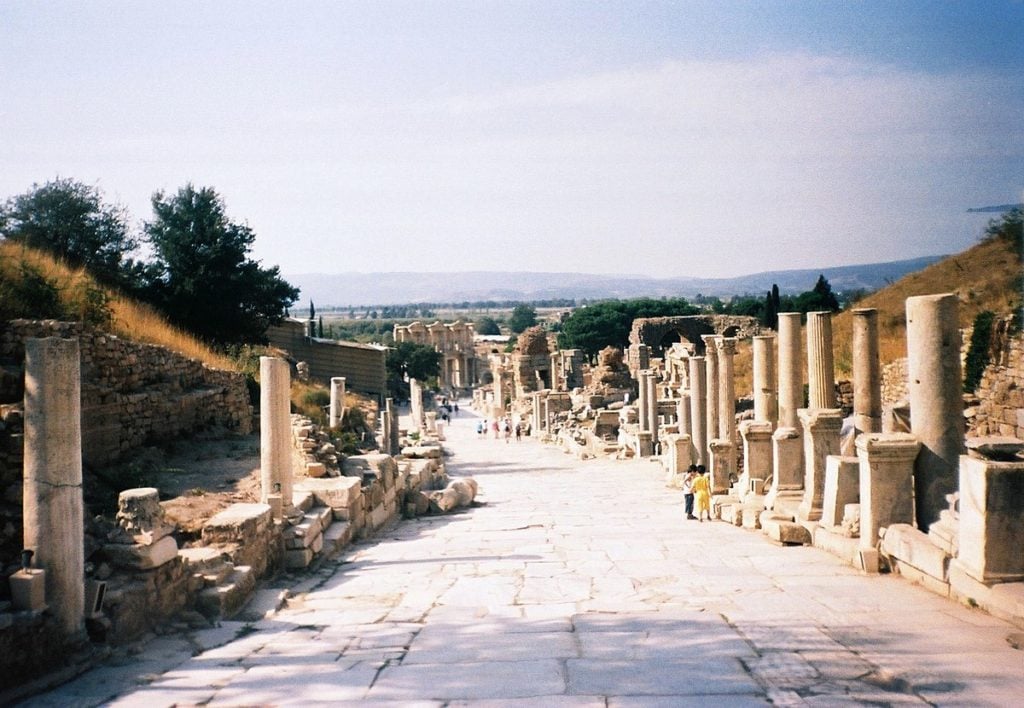
The Greek presence in Ephesus dates back to the Mycenaean expansion of the Late Bronze Age. In 1954, a Mycenean-type burial ground, containing ceramic pots, from around 1500 to 1400 BC, was discovered near the ruins of the basilica of St. John.
The later Ionian colony of Ephesus was founded by the legendary prince of Athens, Androklos, son of king Kodros, in the 10th century BC. It was established on the hill that is known as Ayasuluk today.
The city was once considered the most significant of Greek cities and the most important of trading centers in the Mediterranean region.
Ephesus was a city dedicated to the goddess Artemis. The city originally had a small temple, which was later destroyed and replaced by the temple of Artemision, a magnificent structure which took at least 120 years to be built. This temple was the largest building in Ionia and one of the seven wonders of the ancient world.
A number of historical figures called Ephesus home. These included the elegiac poet Callinus and the iambic poet Hipponax, the philosopher Heraclitus, the great painters Parrhasius and Zeuxis, the sculptor Agasias, and the grammarian Zenodotos. Soranus and Rufus, both physicians, were also amongst these notable figures.
Miletus
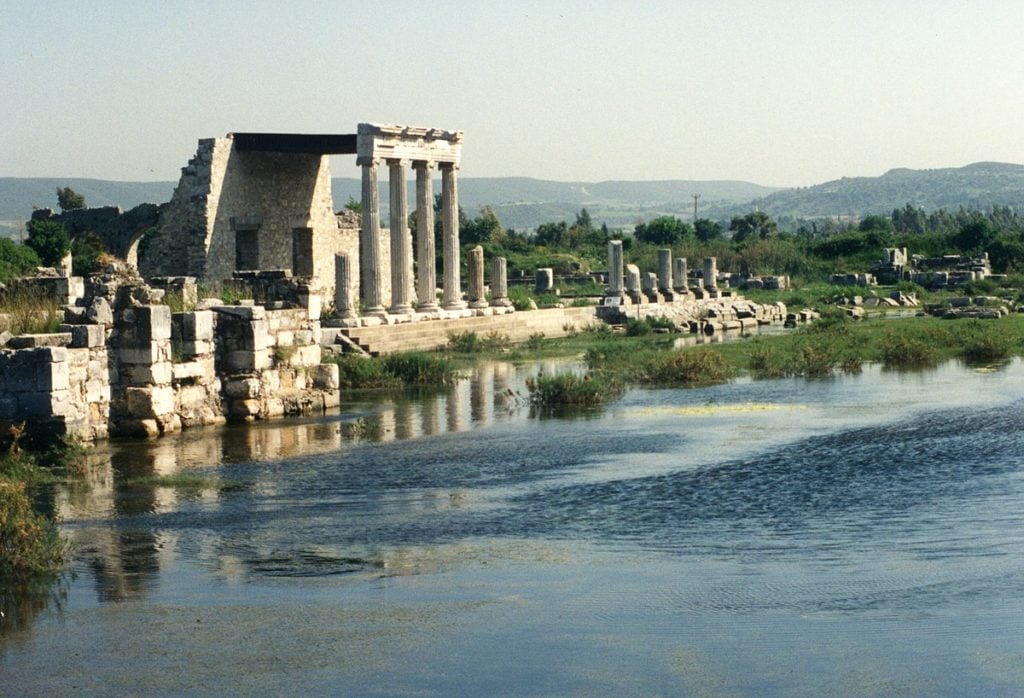
Perhaps one of the first regions with Aegean influence, Miletus’ settlement came under Minoan influence in the Early and Middle Bronze Age and later became a Mycenaean stronghold (1450-1100 c. BC) when the city at that time rebelled against the Hittite Empire.
Records from Mycenaean and Hittite tablets mention the city numerous times. According to Strabo, Miletus was first founded by Cretans. Their leader, Sarpedon, brought over colonists from Miletus of Crete and also named the city after the settlers’ hometown.
The city was extensively resettled by Ionian Greeks. Miletus was considered amongst the greatest and wealthiest of Greek cities and became one of the twelve Ionian city-states of Asia Minor to form the Ionian League.
It also became known for the numerous colonies it founded on the shores of the Black Sea. Miletus was the greatest Greek metropolis and founded more colonies than any other Greek city, among them being Byzantion, Odessos (Bulgaria), Hersonisos (Crimea), Dioskouria (Georgia), Histros/Histria (Romania) and Sinope amongst others. Miletus also played a significant role in the founding of the Greek colony of Naukratis in Egypt.
In addition to its commerce and colonization, the city was distinguished for its literary and scientific-philosophical figures. Thales, Anaximander, Anaximenes, Leucippus, Hecataeus, Actinus, and Hippodamus were among these.
The ruins of this ancient Greek city are located near the modern village of Balat in Aydın Province, Turkey.
Sinope/Sinop
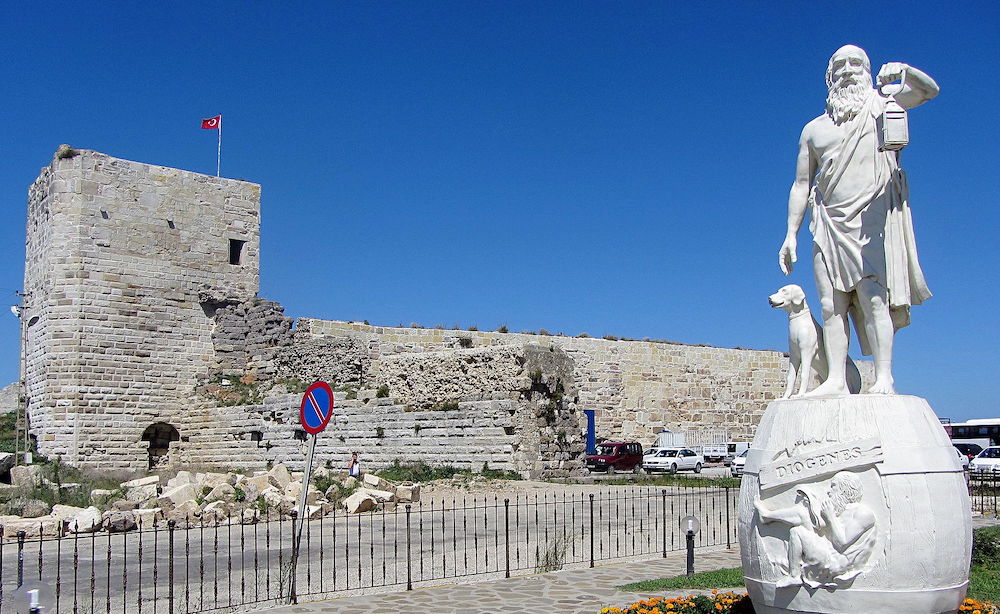
Strabo and the city’s ancient inhabitants ascribed its foundation to the legendary Autolycus of Jason’s Argonauts. It was one of the many colonies of Miletus and was settled at various times by Greeks.
Some scholars claim that the earliest Greek colonization of Sinope dates back to the 7th century BC while others believe it must have been even earlier, around the 8th century BC.
Sinope quickly flourished and developed into a vibrant Greek colony on the Pontus Euxinus. It enjoyed naval supremacy in the Black Sea, as it was the most important terminus of trade routes.
The most notable historical figure of Sinope is, of course, the philosopher Diogenes, the so-called Diogenes the Cynic.
The Greek city of Sinope is situated on the northernmost edge of the Turkish side of the Black Sea coast, in the ancient region of Paphlagonia, in modern-day northern Turkey.
See all the latest news from Greece and the world at Greekreporter.com. Contact our newsroom to report an update or send your story, photos and videos. Follow GR on Google News and subscribe here to our daily email!



